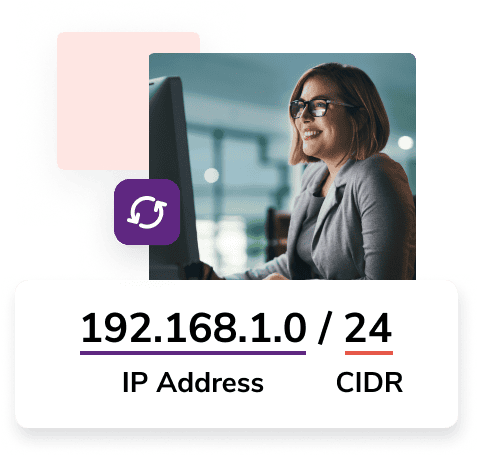Convert CIDR to IP Range
Use the free CIDR to IP range converter and retrieve your IP range details in seconds. Just enter your CIDR notation in the provided field and hit ‘Convert.’
Use the free converter ➜
Or - convert IP to CIDRCIDR to IP Range Converter


How to use the CIDR to IP range converter
To use the CIDR to IP range converter, you’ll just need to provide a value for the CIDR notation.
CIDR consists of an IPv4 address followed by the bitmask (e.g., 192.168.1.0/24). The first number is the prefix, while the latter is the netmask (number of reserved bits).
Then, just hit ‘Convert’ to get your IP range details.

Why convert CIDR to IP range?
Using the IP range converter gives you the freedom and agility to switch between CIDR notation and IP range for easier IP management.
Some administrators may still use classful addressing, making IP range necessary. Depending on your skill level, this may prove easier to understand.
Using the CIDR to IP range converter gives you all of the information you need to know for network management, including
- ✓ Start and end IP
- ✓ Netmask
- ✓ Total IPs in range
- ✓ Usable IPs in range
- ✓ Binary netmask
- ✓ Broadcast
- ✓ Wildcard mask
- ✓ Country & country code
- ✓ Class

CIDR to IP range use cases
Network management tool configuration
IP range and classful addressing is generally more accessible for most security specialists or network administrators to understand. Classful addressing is the predecessor of classless addressing, and most principles of the latter are based upon it.
With that in mind, some network managers may still rely on classful addressing. In these scenarios, it’s helpful to be able to convert CIDR to IP range quickly.
Email server configuration
Likewise, your company’s postmaster may have a server routed using classful addressing. For this, IP ranges would be used to route data packets as opposed to CIDR notation.

Note: Classful addressing is widely considered obsolete, as CIDR (classless addressing) provides more flexibility and significantly reduces IPv4 waste. You can convert to CIDR using our free tool below.
Convert IP range to CIDRGet IPv4 address monitoring and more email deliverabilityⓘA sender’s ability to reach the recipient’s inbox with their outgoing emails. It may also describe the ratio of emails delivered to the inbox vs. those sent to spam or blocked by the receiving server. tools
Our free CIDR to IP range converter gives you the freedom to swap between classless and classful addressing as needed. But there’s more at play that determines successful email delivery than your IPs.
ZeroBounce’s email deliverability platform gives both email server administrators and email marketers the tools they need for business success. Create your free account today and get immediate access to:
100 credits (no expiration)
Email validation - Detect 30+ email address types, including invalid, disposable, abuse, spam traps, and more
Catch-all Scoring - Score your catch-all emailsⓘAn email set up by a business to capture email messages sent to their name via an invalid address (e.g., j0hn@company.com instead of john@company.com). Catch-all inboxes receive a high volume of spam and may not be actively monitored by the owner. to find out which inboxes are being managed
Activity Data - Trace subscriber activity in the last 30, 60, 90, 180, 365, and 365+ days
Email server testingⓘA ZeroBounce service that analyzes an email server’s configuration by performing 100+ checks regarding header information, RFC documents, DNS records, email ports, and email authentication.
Header information
RFC-based testing
DNS checks
Email ports
DMARC analysis
100+ tests in total
Inbox placement testingⓘA process that allows users to analyze how an email performs with various email service providers before sending the campaign to a real audience. The test identifies errors with the header, body, and footer to help users remedy problems that prevent them from reaching the inbox.
Test emails against 20+ providers
Google, Outlook, Yahoo, Comcast, iCloud, and more
Spamhaus, Kaspersky, Symantec, Net-C, and more
Email FinderⓘA tool that allows users to look up an email address by using either a name, an email domain, or a combination of both data points.
Name-based queries
Domain-based queries
Blacklist MonitorⓘA service that actively observes your email domain and IP address while comparing it to known email blacklists and antispam services around the internet. If a blacklist flags either the domain or IP, the monitor will notify the user.
Domain/subdomain monitoring
IPv4 address monitoring
IPv6 address monitoring
API
Multiple API keys
60+ integrations
Documentation for all services
Manage from desktop or iOS
The No. 1 email validationⓘA process that determines if an email address uses valid syntax, exists on a given domain, and is configured to receive incoming email messages service for 400,000+ clients
Frequently asked questions
A CIDR to IP range converter rapidly converts a CIDR block notation into an IP range with a starting and ending IP address. The converter also yields other helpful information, including the total number of usable IPs in the range as well as the class type.
Classless Inter-Domain Routing (CIDR) routes data to IP addresses based on the IP prefix or subnet mask rather than the IP class.
IP or an IP range is considered classful addressing, while CIDR, by both name and definition, is classless addressing. Classful addressing separates IPv4 addresses into 5 classes (A, B, C, D, and E). Classless addressing doesn’t use these classes but instead relies on the IP’s subnet mask for addressing.
Classful addressing is a primarily obsolete form of inter-domain routing and has no real advantage over classless routing. However, some network administrators still work with classful architectures or use ideas based on those concepts.
Classful IP routing is based upon five set classes with no room for deviation. As a result, a large number of IP addresses are wasted when there are already fewer IPv4 addresses available. Classless addressing, aka CIDR notation, overcomes this issue by routing based on the subnet mask rather than class.